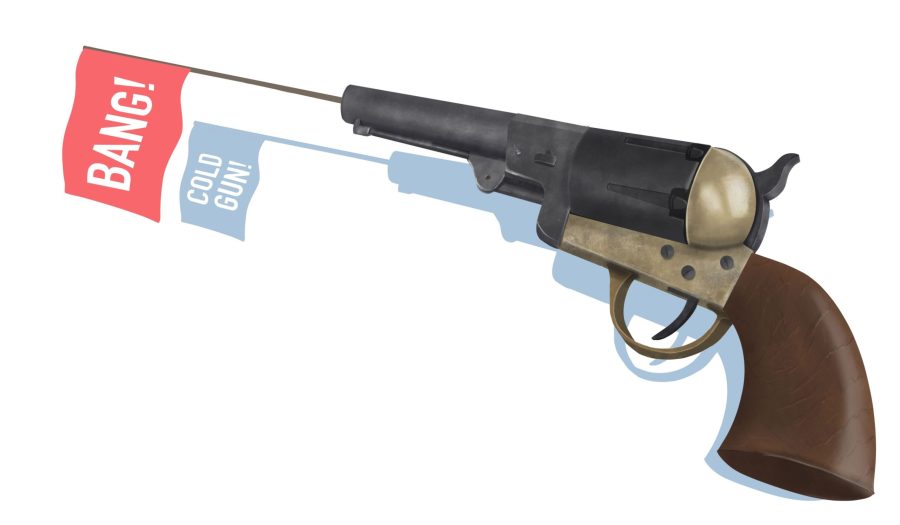Recently, the media has blown up with countless articles recalling an incident on the production set of “Rust,” an unreleased Old Western film. The unfortunate circumstances involved prominent actor Alec Baldwin, and his accidental firing of a prop gun that killed cinematographer Halyna Hutchins during a scene rehearsal. When I first heard about Hutchins’ untimely and tragic death, I was shocked to the point of disbelief. I’m sure I wasn’t the first or only person to think, “Why was there a real gun being used on set?” The answer is shocking: authentic guns filled with blanks are incredibly common in the film industry and this isn’t the first time that someone has been gravely injured by the presence of a real firearm on set. However, even after all of these unfortunate calamities, the film industry continues to place their obsession with providing realistic action-packed entertainment above the safety and well-being of their employees all for the sake of content creation. The implementation of “safety” measures and guidelines is simply not enough; a more sensible solution is a ban on firearms being used on set.
Prior to the gradual implementation of safety measures on film sets, deaths on film sets stood perilously high with one five-year span in the 1930s containing over 30 reported deaths. From 1990 up until 2004, there have been at least 194 life-threatening accidents as well as 43 reported deaths on movie and television sets in the United States alone. While safety guidelines appear to be effectively limiting the occurrence of injuries and deaths on set, there is always room for error. Unfortunately, when loaded firearms are involved, error results in unnecessary death and injury.
For example, on the set of “Rust,” it’s been revealed that the gun was not thoroughly checked and the production team had been taking shortcuts on safety standards, including opting out of insurance packages and subjecting employees to poor working conditions. There were also two separate occasions on the same set that involved the misfiring of firearms in the days leading up to Hutchins’ death. Both mishaps involved explicit errors in communication where the crew was told the firearms contained no live ammunition or blanks. This obviously wasn’t the case when the triggers were pulled. Despite these previous mistakes, errors continued to be made, and, in this case, it has led to disastrous circumstances.
Furthermore, the safety “guidelines” set in place are nowhere near equivalent to the severity of firearm regulation laws. In the U.S., there are no official overarching rules on the proper handling of firearms on set. The U.S. Federal Workplace Agency leaves the responsibility of creating and enforcing safety measures to the discretion of the film industry itself. Some companies, like Warner Brothers, have formulated their own individual policies, but others are not as strict or careful. This decision to leave the safety of workers in the hands of the film industry is a dire mistake and a substantial issue when the main motivations and priorities of the industry are considered. It’s no secret that this money conglomerate is highly driven by revenue, meaning it often has absolutely no qualms with sacrificing the well-being of its workers in order to accumulate the most profit. We’ve continually seen this type of sacrificial behavior not only with safety regulations, but feigned ignorance and an utterly disappointing lack of intervention over sexual assault, unequal compensation, discrimination, etc. Ultimately, this industry that is so willing to sacrifice the health and success of its employees in order to save money cannot be trusted with implementing the proper set of rules or handling enforcement. Outside intervention on the federal level is needed in order to push a ban on firearms being used on sets and prevent future incidents from ever taking place.
On the off chance that someone points out the rarity of shootings on set occurring, it’s important to ask the larger question of why do they occur at all? There is simply no need to have loaded guns on set that put the lives of others at risk all for the sake of creating “realistic” entertainment. Not to mention we have developed incredible digital techniques that can render and imitate the discharge of firearms without putting anyone in harm’s way. Even if these digitized versions are not entirely the most realistic, they are a very viable and obvious solution to an absolutely needless issue.
Films are intended to be forms of thoughtful and thought-provoking art; they should not involve unnecessary dangers that put the lives of the crew at risk. We have the options and capabilities to eliminate the risk of using real firearms on set, and it should never have taken the death of Hutchins to remind us of that. Now is the time to make changes within the film industry to ban the use of real firearms on set and prioritize the safety and well-being of employees over profit in order to prevent future mistakes and deaths in an industry originally intended for creation and expression.
Art by Andrew Diep for UCSD Guardian.














